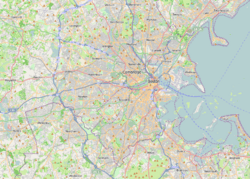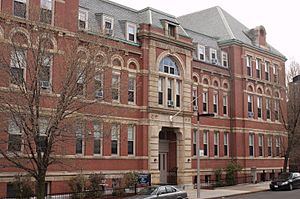Fort Hill, Boston facts for kids
Quick facts for kids |
|
|
Fort Hill or the Roxbury Highlands Historic District
|
|

Fort Hill's name originates from the American Revolutionary War fortification built in the center of the district, now the location of the Cochituate Standpipe.
|
|
| Location | Boston, Massachusetts |
|---|---|
| NRHP reference No. | 89000147 |
| Added to NRHP | February 22, 1989 |
Fort Hill is a neighborhood and a historic area in Roxbury, Boston, Massachusetts. It covers about 0.4 square miles.
Fort Hill was very important during the American Revolutionary War. It was where the American patriot army built defenses during the Siege of Boston. The neighborhood gets its name from a fort made of earth that the army built on the hill. This hill is now called Highland Park. You can find a tall Victorian-era tower there. It was designed by Nathaniel Jeremiah Bradlee. The park's design was created by Frederick Law Olmsted.
Fort Hill grew quickly in the 1800s as more people moved in. This happened especially after streetcar service reached Boston. Today, you can get to Fort Hill using the Massachusetts Bay Transportation Authority's Orange and Silver Line trains. The neighborhood has many types of buildings. These include old Greek Revival and Italianate houses. There are also classic Boston triple-deckers, row houses, and newer green buildings. Fort Hill is sometimes called Highland Park. It was added to the National Register of Historic Places on February 22, 1989.
Contents
Historic Places to Visit
First Church in Roxbury
Fort Hill is home to the First Church in Roxbury. This church was started in 1631. It was the sixth church ever founded in New England. The church has had five different buildings on its site. The current building was built in 1803. It is the oldest wooden church building still standing in Boston.
The First Church of Roxbury was the starting point for the famous Midnight Ride. This ride happened on April 18, 1775. William Dawes began his ride here. He and Paul Revere were sent by Joseph Warren. Their job was to warn Lexington and Concord that the British were coming. Today, the First Church is the main office for the Unitarian Universalist Urban Ministry.
Dillaway-Thomas House
The Dillaway-Thomas House is located at 183 Roxbury Street. Patriots used this house during the Revolutionary War. It was built as a home for the minister of the First Church in Roxbury. Construction started in 1750.
During the Siege of Boston, from April 1775 to March 1776, the patriot army camped in Roxbury. Major General John Thomas used the Dillaway-Thomas House as his headquarters. This house is now part of the Roxbury Heritage State Park.
Roxbury High Fort
The Roxbury High Fort was very important during the American Revolutionary War. It played a big role in the Siege of Boston. This fort is located on what is now Beech Glen Street. It is the reason Fort Hill got its name.
Fort Hill's Past
From Farms to Forts
Before the American Revolutionary War, Fort Hill was mostly farms. It had country estates and pasture land. But this area was very important for the American colonists. It helped them resist the British during the Siege of Boston. The only road connecting the mainland to Boston went through Fort Hill.
The high ground and rocky areas of Fort Hill made it a great spot for the Continental Army to build forts. In the summer of 1775, the army built two forts here. These forts were part of a circle of defenses. They eventually helped force the British to leave Boston. The Revolutionary War destroyed many old buildings in Fort Hill. The Dillaway-Thomas House is the only building left from before the war.
Growing as a Neighborhood
Fort Hill started to change from farms to homes in the early 1800s. In 1803, Washington Street was improved. It became a main road connecting Boston to Rhode Island. By the 1820s, horse-drawn buses carried people from Fort Hill to Boston. In 1835, a railroad was built nearby. These better ways to travel brought wealthy people and businessmen to Fort Hill.
Becoming a Streetcar Suburb
Roxbury became part of Boston in 1868. This led to many new homes being built in Fort Hill. In 1869, Roxbury built the Cochituate Standpipe. This tower helped modernize the water system. It is now the most famous building in the neighborhood.
Electric trolley service began in 1889. This made Fort Hill even more popular. Many people moved there. This created a demand for row houses, triple-story homes, and single-family houses.
In the early 1900s, many immigrants moved to Fort Hill. They came from England, Ireland, and Germany. You can see German influence in some of the buildings near Egleston Square. Later, in the 1940s and 1950s, more people moved in. Many African Americans came from the American South. This was part of the Great Migration. After this, Fort Hill and Roxbury became known as the "heart" of black culture in Boston.
Fort Hill Today
Today, Fort Hill is a diverse community. People from many different backgrounds live there. It has many residents with Irish, Puerto Rican, Dominican, German, and African roots. In recent years, more professionals, artists, and students have moved to Fort Hill. Many students attend nearby schools like Northeastern University or Massachusetts College of Art and Design.
Getting Around Fort Hill
Fort Hill has good transportation options. These include bus and train services, roads, and bike paths.
- The rapid transit Orange Line runs along the west side of Fort Hill. It stops at [[{{{station}}} (MBTA station)|{{{station}}}]] and [[{{{station}}} (MBTA station)|{{{station}}}]].
- Nubian station is a big hub for MBTA bus services. This includes the Silver Line.
- Major roads in Fort Hill include Washington Street, Columbus Avenue, and Malcolm X. Boulevard.
- There are also bicycle paths. The Pierre Lallement Bicycle Path runs along the Southwest Corridor Park.
Learning in Fort Hill
Fort Hill is served by Boston Public Schools. These schools assign students based on their preferences and where they live. Fort Hill has several schools for different age groups. These include Nathan Hale Elementary School (grades PK–5) and Timilty Middle School (grades 6–8). The John D. O'Bryant School of Math & Science (grades 7–12) is also here. Fort Hill also has two colleges: Roxbury Community College and Emmanuel College's retreat center.





